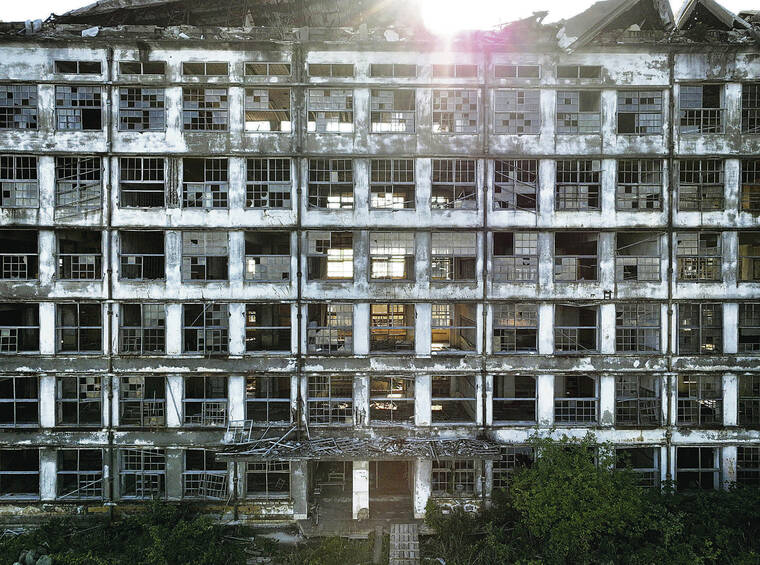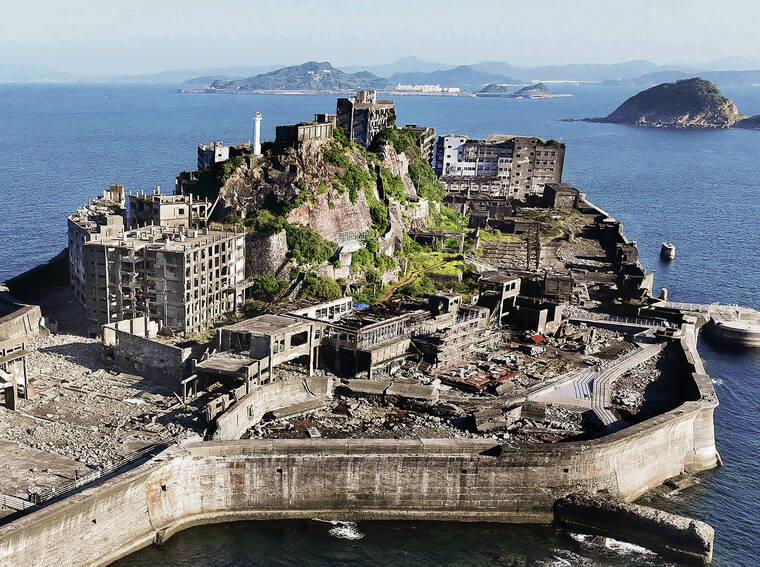The abandoned island

JAPAN NEWS
Above, the building for Hashima’s elementary and junior high school, constructed in 1958, lies on the northern part of the island.

JAPAN NEWS
A high seawall runs around the perimeter of Hashima Island.


TOKYO >> On an island off the coast of Nagasaki, ruins that seem on the verge of collapse stand clustered behind a high seawall. Though officially known as Hashima, the island is sometimes called Gunkanjima (Battleship Island) because of its resemblance to the 1920s warship Tosa. Last year marked the 50th anniversary of the closing of Hashima’s coal mine, which once made the spot prosperous.
High-quality coal was discovered on Hashima around 1810. During the island’s heyday, about 5,300 people lived there, making it the most densely populated island in Japan. Within its 1.2-kilometer (three-quarters of a mile) perimeter were most of the structures a community would require for daily life, including an elementary and junior high school, hospital, post office and nursery school.
The island was closed in 1974 and fell into disrepair, but since the 2000s, it has been reborn as a tourist destination. In 2015, the Hashima Coal Mine was added to the World Cultural Heritage list as one of the Sites of Japan’s Meiji Industrial Revolution. Preservation work is also underway.
Walking the island, visitors can tell that many years have passed since its closure by the overgrowth of trees. With only the lonely sound of waves now echoing off the island, it’s difficult to imagine the hustle and bustle that once existed. In the springs of years past, there was the annual Hashima Shrine festival, and in the summer, there were fireworks displays and bon dancing.
From a high perch, visitors can see the collapsed shrine hall, with only a miniature shrine left intact. There is also a slide on the roof of the No. 65 Apartment Building, which served as company housing for the miners, its walls and pillars heavily cracked. At another building, plants that formerly were found only in the rooftop vegetable garden now bloom brightly among the rubble.
“I have good memories of playing quietly, caring for the miners who were tired from their night shifts and sleeping during the day,” said Minoru Kinoshita, 71, who lived on the island for 12 years. Despite how desolate the island may be, his feelings for his hometown remain warm.
Don't miss out on what's happening!
Stay in touch with breaking news, as it happens, conveniently in your email inbox. It's FREE!
“When I go to the island, there are so many nostalgic memories that I feel like I’m the age I was back then.”
Although most of the island is off-limits to visitors, it has been in the spotlight as the setting for TV dramas and movies, including the 2012 James Bond film “Skyfall,” and attracting tourists from all over the world.
This year marks a decade since the island was added to the World Cultural Heritage list. This small hump of land that once supported Japan’s economic growth seems to have found a new place for itself in the world.




